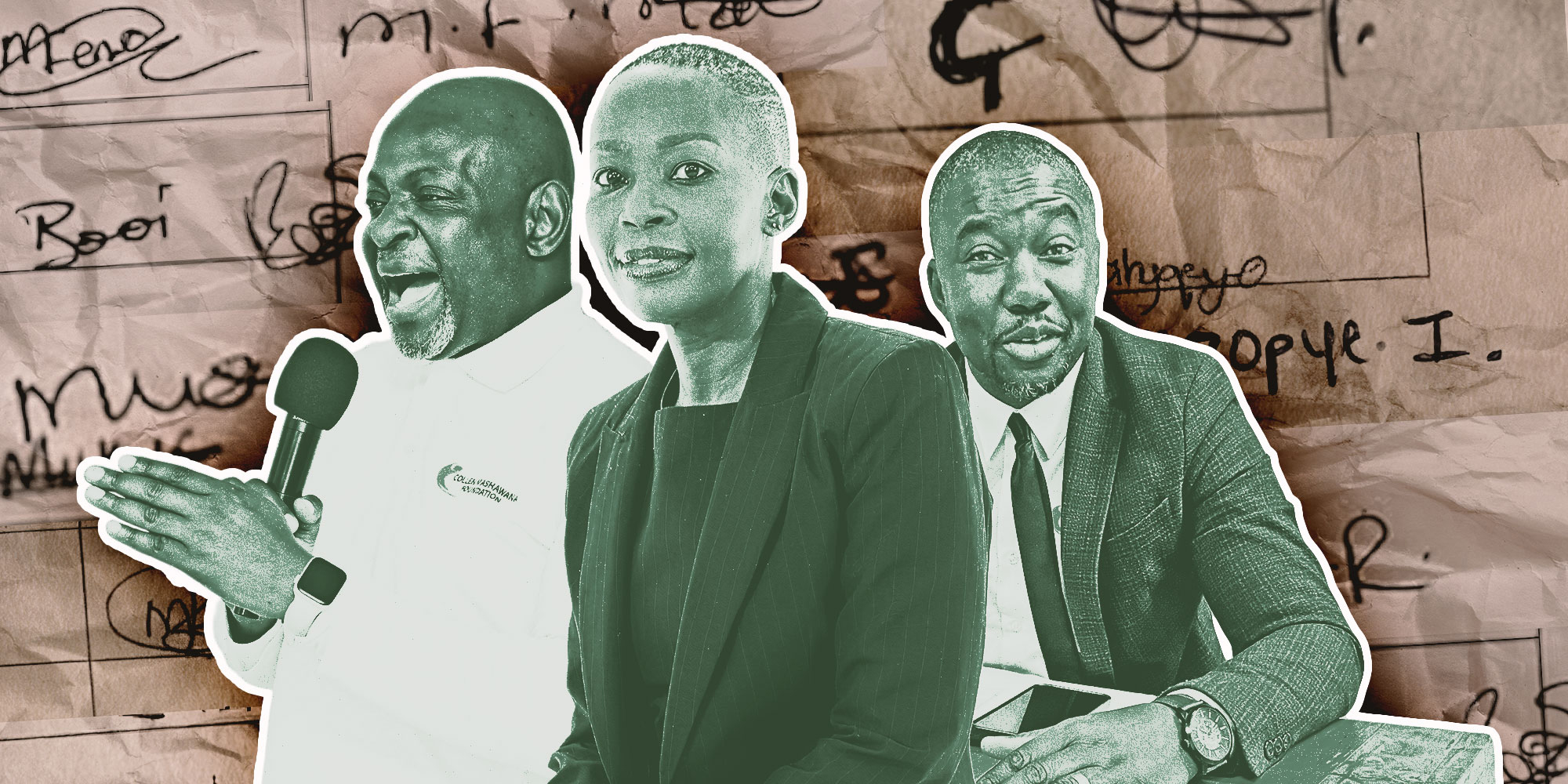The charitable foundation named in Daily Maverick’s sensational video “sting” project submitted thousands of allegedly forged signatures to the Independent Development Trust (IDT).
This was to claim millions of rands in salaries on behalf of impoverished participants in an Expanded Public Works Programme (EPWP) initiative, money that in many instances did not go to the workers.
Daily Maverick obtained documents containing thousands of signatures and initials that supposedly belonged to 700 EPWP participants from Limpopo. These workers had contracts with the Collen Mashawana Foundation (CMF) to do bits of manual labour in Thohoyandou and surrounds. The programme was bankrolled by the IDT, which had given the CMF a R60-million contract to run employment schemes in Limpopo and in four other provinces. The CMF clinched the EPWP contract during suspended IDT CEO Tebogo Malaka's time in charge of the organisation.
To claim monthly payments from the IDT, the CMF had to regularly submit payment sheets and attendance registers signed by the workers. The foundation also submitted a document bearing sample signatures of its 700 EPWP employees, known as a specimens sheet.
Daily Maverick in May travelled to Limpopo, where several EPWP workers indicated that the signatures on the documents weren’t theirs.
We then gave copies of the documents to a leading forensics firm, one that specialises in signatures fraud and related document analyses.
Our experts’ scientifically-based work regularly features in legal proceedings, and their findings have secured several criminal convictions. Having scrutinised the IDT documents over a period of several months, they’ve identified compelling inconsistencies and discrepancies in the EPWP documentation. The firm’s findings are highly concerning: whoever submitted the documents to the IDT likely committed large-scale alleged signatures fraud in order to claim the workers’ funds.
/file/dailymaverick/wp-content/uploads/2025/08/Collen-Mashawana-Facebook.jpg)
To date, the IDT has transferred at least R27-million to businessman and self-described “philantrepreneur” Collen Mashawana’s eponymous foundation. The bulk of these funds were meant to go to the EPWP workers, but Daily Maverick has so far identified scores of participants from the Free State and Limpopo who were either short-changed or not paid at all.
One of the documents in question is a payment sheet dated January 2025. This payment sheet was submitted to the IDT by CMF in order to secure the release of funds. But several EPWP workers indicated to us that their signatures on this document had been forged. They also showed us their bank statements, proving that they didn’t get paid for that month’s work. Meanwhile, financial records in our possession indicate that the IDT had transferred more than R1-million to Mashawana’s foundation on the back of its claim for January’s salaries.
In this instalment of Daily Maverick’s ongoing IDT series we unpack the forensic experts’ astonishing findings. The investigators combed through roughly 7,000 individual signatures and more than 23,000 initials, all captured in the payment sheets, attendance registers and specimens sheet the CMF submitted to the IDT between August 2024 and March this year. In other words, while Daily Maverick only has select workers’ confirmation for the January payment sheet, the forensic experts examined the totality of the documentation in our possession. They found evidence for the alleged fabrication of signatures in documents submitted to the IDT over the course of seven months.
The Collen Mashawana Foundation, its founder and its CEO did not respond to detailed queries.
Read more: IDT vows to probe Collen Mashawana Foundation’s ‘signatures fraud’
Clusters of signatures by one writer
Chief among the experts’ findings is their discovery that one person had produced entire clusters of the workers’ purported signatures.
The methodologies that informed this and other conclusions speak to the well-developed, near incontrovertible science that embodies contemporary forensic handwriting analysis.
To determine that one person reproduced whole clusters of signatures, the investigators looked for inherent handwriting traits that are extremely difficult to mask, especially when the alleged forger has to produce signatures in such large volumes.
“The purpose of forgery is to mislead by pictorial image, so think of each signature as a picture. We go beyond looking at the image as a whole and instead focus on the myriad elements that make up a single signature or piece of handwriting,” explained one of our experts.
/file/dailymaverick/wp-content/uploads/2025/11/Hand-signature7.jpeg)
A forger would try to hide their unique handwriting characteristics, but to do this convincingly requires considerable artistic ability.
“To disguise your own handwriting means you have to overrule strongly-embedded fine motor neuron patterns. Very few people have the skill to do this.”
Whoever produced the clusters of EPWP signatures did not possess such skills.
Our experts determined that this person consistently reverted to their own unique traits.
What the examiners looked for were elements of form, construction and execution inherent in each individual’s handwriting.
“In a typical document examination, there are about 21 elements that are assessed,” reads the report our experts drafted for us.
These elements include the slant, slope and spacing in a handwriting sample, pen control and diacritics. The latter refers to the small marks required to complete certain letters, such as the dot in the letter “i”.
The examiners also assess baseline habits (how people position their letters or words in accordance with the imaginary line we all seek to maintain when we write); connecting strokes (the lines that connect elements of a single letter, or those that bind letters together to form a word); and point load, which is the angle of a pen as it makes contact with a sheet of paper.
Guided by this multi-pronged approach, our experts identified a case of common authorship across multiple signatures in the EPWP documents. In other words, many of the workers’ so-called signatures were, in fact, produced by one person.
/file/dailymaverick/wp-content/uploads/2025/11/Hand-signature10.jpeg)
Spelling
The alleged forgers made some very obvious mistakes too.
There were clear spelling variations, or spelling mistakes, in individual workers’ purported signatures. These mistakes are evident across the various months’ payment sheets and attendance registers.
“A signature is a highly personal and individualised mark of an individual. It is probably the most written of all handwriting features. People create a signature to ‘match’ their individual style. When the signature is practiced and executed continuously, the execution thereof becomes a fixed, subconscious neuromuscular task with very little thought or feedback to the brain,” reads the report.
“It is highly irregular that an individual’s basic construction (form) of their signature, and especially the spelling thereof, is inconsistent from one signing to the next.”
Whoever committed the alleged fraud evidently struggled with the surname Hlungwane. In several instances, this surname was spelt with an "i" at the end instead of an "e".
Inconsistent initials and signatures
There were also noticeable variations in the visible presentation of many participants’ signatures.
In fact, the investigators found that this phenomenon was prevalent throughout most of the documents they’d assessed.
“The signatures of all individuals are highly inconsistent from one signing to the next. This inconsistency is evident in the basic form (model) of the signatures as well as in the execution of similar models,” reads the report.
These inconsistencies led the forensic firm to make yet another damning finding: “This inconsistency is highly irregular and strongly supports the proposition that the signatures are not individual, naturally signed signatures, but rather that they were fabricated.”
/file/dailymaverick/wp-content/uploads/2025/11/Hand-signature6-1.jpeg)
/file/dailymaverick/wp-content/uploads/2025/11/Hand-signature5-1.jpeg)
Please support our journalism. Become a Daily Maverick Insider here.




 Collen Mashawana, founder and chairman of the Collen Mashawana Foundation. | Tebogo Malaka, suspended IDT CEO.(Photo: IDT) | Austin Mashawana during an interview at the Collen Mashawana Foundation’s Rivonia offices in June. (Photo: Pieter-Louis Myburgh)
Collen Mashawana, founder and chairman of the Collen Mashawana Foundation. | Tebogo Malaka, suspended IDT CEO.(Photo: IDT) | Austin Mashawana during an interview at the Collen Mashawana Foundation’s Rivonia offices in June. (Photo: Pieter-Louis Myburgh) 

